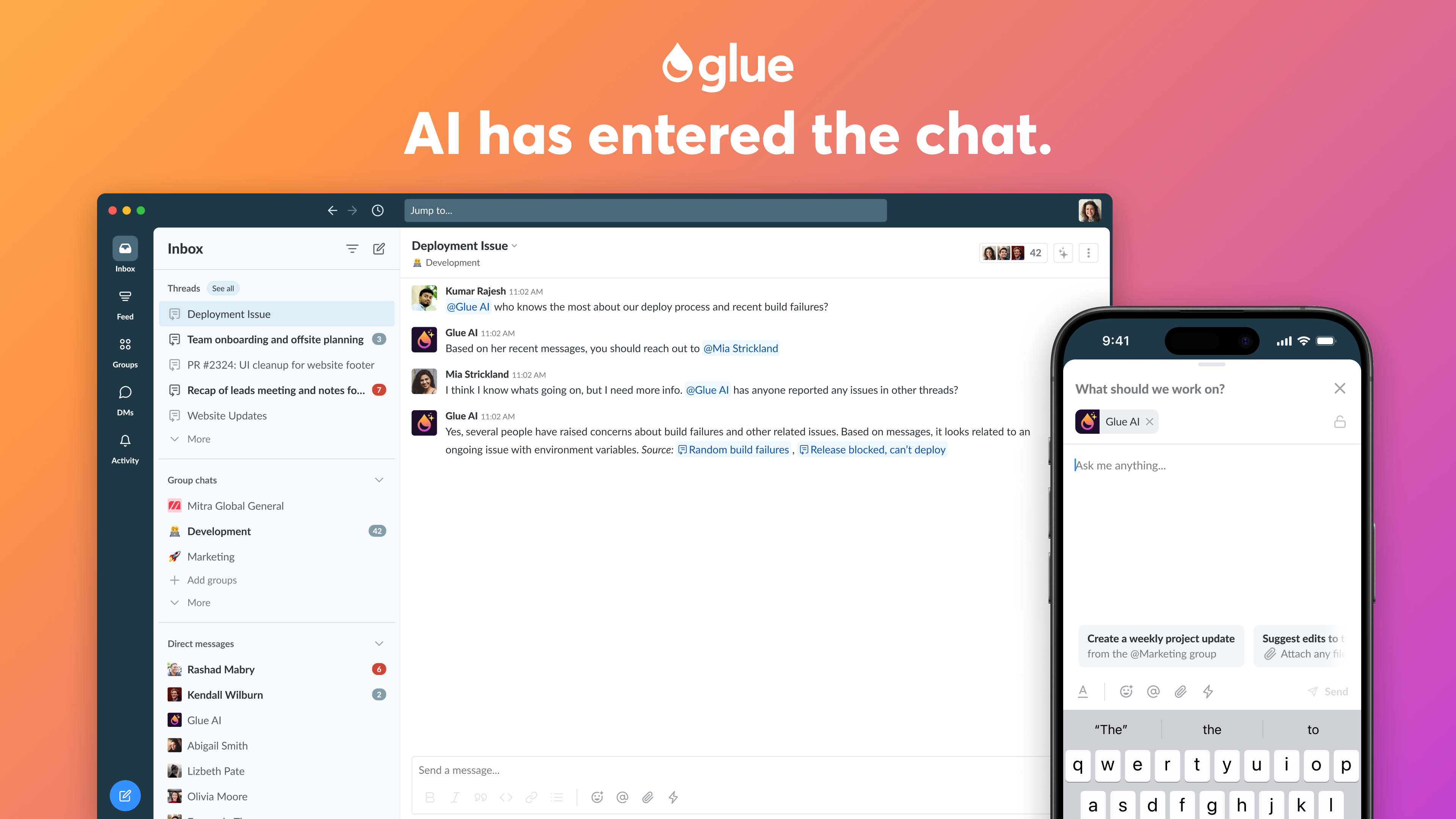

If you use Slack at work, you’ve likely noticed that the number of channels you’re invited to proliferates incessantly.
David Sacks, one quarter of the popular “All In” podcast and a renowned serial entrepreneur whose past companies include Yammer – an employee chat startup that sold to Microsoft for $1.2 billion in 2012 – says he can solve this problem. Toward that end, he teamed up with Evan Owen, formerly the VP of engineering at a collaboration app, Zinc, that ServiceMax acquired in 2019.
The two of them have created Glue, an employee chat app that they say will fix what they call “Slack channel fatigue.” Glue, which emerged from stealth on Tuesday, is designed around topic-based threads and uses GenAI.
Craft Ventures, the VC firm that Sacks founded, incubated and funded the company through multiple seed rounds. Glue was born in 2021 when Sacks and Owen, then an entrepreneur-in-residence at Craft, decided they each had many ideas about improving workplace messaging, and the space was due for an update.

“Our view was that there’s still a lot of room for innovation,” said Sacks, who is Glue’s co-founder and chairman. “If you talk to people about Slack, even though it’s a good product, they feel like channels are really noisy, and it’s a lot to keep up with.”
On Slack, discussions happen in specific channels. This means anyone who wants to chat with a group, even for a short message, needs to join that channel. However, since most people stay subscribed to channels they rarely use, it can feel like everyone in the company is on every single channel, which can be overwhelming.
Glue arranges all communication into threads. An individual or a team can start a thread, and other teams and even Glue’s AI bot can be invited to join it.
In many ways, Glue’s interface looks similar to Slack’s, but everything a user sees on their screen is intended specifically for them.
“You can create a thread for a specific short task,” said Owen, Glue’s co-founder and CEO. “It’s an ephemeral conversation, and when you’re done with it, it can go away.”
An employee can archive the conversation, and if they are mentioned again, the chat will pop up again, he said.
While organizing work messaging in threads instead of channels may feel like a throw-back solution to reducing communication clutter, Sacks said he is sure that this is something Slack and its main alternative, Microsoft Teams, can’t easily replicate.
“In order to copy what we’ve done, they would have to completely re-architect the way the whole product works,” he said.
If this sounds vaguely familiar, that could be because Yammer (which has more or less morphed into a product called Microsoft Viva, although Microsoft Teams also allows employees to chat, in addition to to do team video calls), was a thread-based chat as well. Yammer looked similar to Facebook.
But Glue gave Sacks and Owen a chance to recreate thread-based chats in the age of AI. So, like most startups now, Glue is incorporating AI into its product.

“We made AI into a virtual employee on your team who can enter the chat at any time,” Sacks said.
Sacks believes that AI inside a company’s internal communication platform can be very powerful.
“Sometimes you’ll start a chat with your coworkers and then realize you need AI to jump in and answer a question. So, you want your AI chat to be in the same place as your human chat,” he said. “It doesn’t make sense to send users out somewhere else to chat with the AI and then have their kind of human chats on some other app.”
While Glue AI’s role will evolve as underlying LLMs improve, Sacks said there are already some things the bot can do with a certain level of precision. Glue AI can suggest topic names for each thread, summarize conversations across a span of time, and figure out certain information about employees based on their chat history, such as what is their role within the company.
Of course, AI embedded into the corporate chat app isn’t unique to Glue. Slack also has an integrated AI, and of course Microsoft has embedded its CoPilot AI into many of its apps including Microsoft Teams.
Craft Ventures has been using Glue internally for a year, and starting Tuesday the product will be offered to other companies.
After a three-month trial period, Glue will charge $7 per employee a month, which Sacks said is slightly less than Slack’s pricing for a basic package.
Owen added that it’s a “killer deal” because Slack charges between $15 to $18 to include SlackGPT, the AI chatbot that Slack’s owner Salesforce announced a year ago.
Glue is not the first startup Sacks incubated in Craft Ventures. In the last few years, Craft started Callin, a social podcasting app that later sold to Rumble for less than the company raised in funding, Axios reported. Last year, the venture firm launched SaaSGrid, a startup that keeps track of SaaS metrics.
Sacks hinted that Glue may be ready to raise its first external funding shortly after unveiling of the app.
“We want to launch and show people how awesome the product is,” Sacks said. “If you have a great product in the AI space, you can raise a Series A right away.”
As for what valuation Craft hopes the company will attract, he said, “You never really know where the valuation is going to land until you have a process.”
He’s been teasing the coming of his new AI company on “All In,” which he co-hosts with fellow investors Jason Calacanis, Chamath Palihapitiya and David Friedberg, “Besties have been clamoring to invest [in this],” he said, referring to his All In co-hosts.
Given that he’s positioning Glue as an AI company, and maybe his besties do want a piece, it’s clear he’s hoping for a high valuation.





